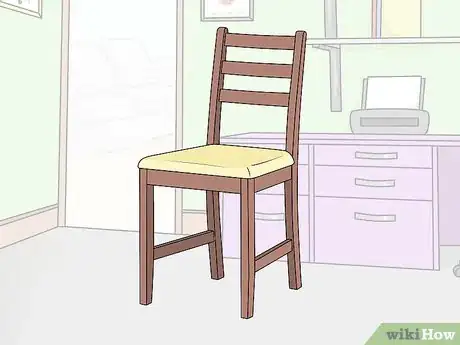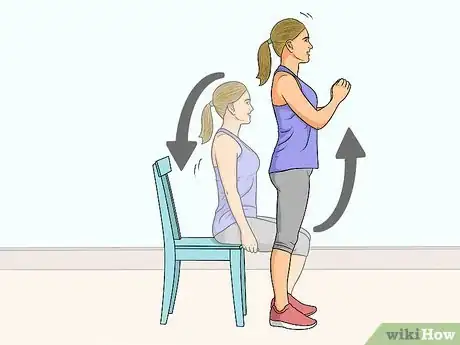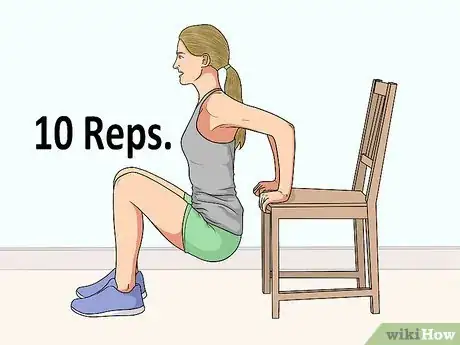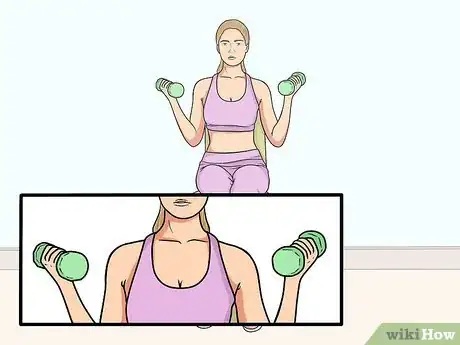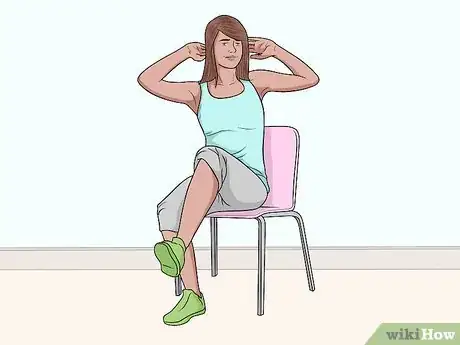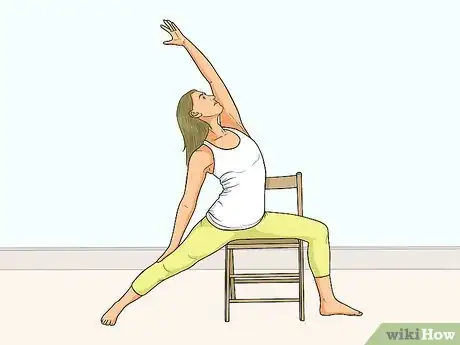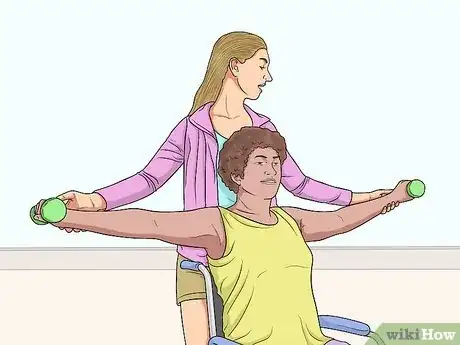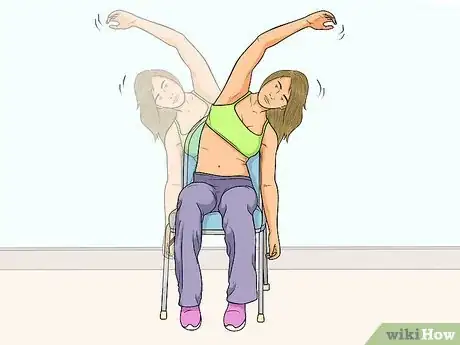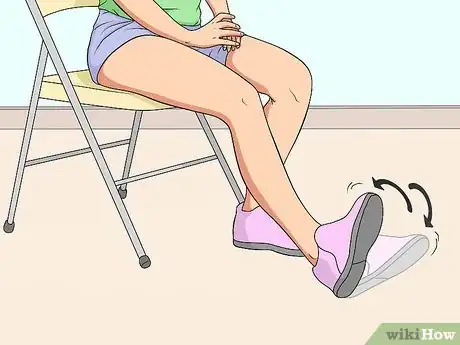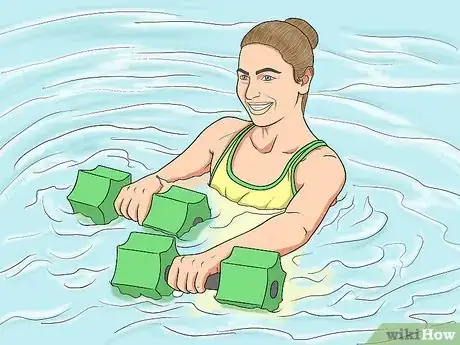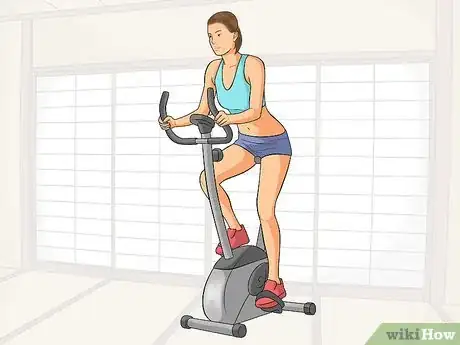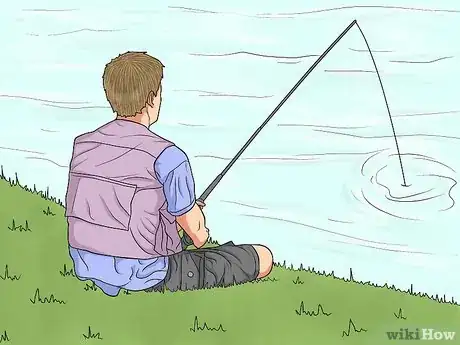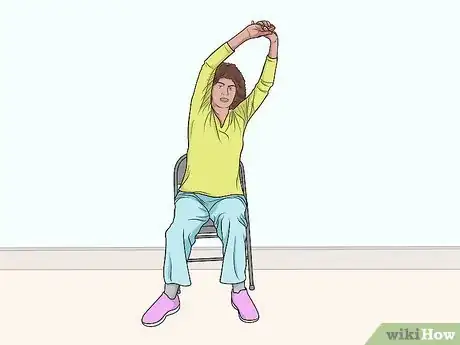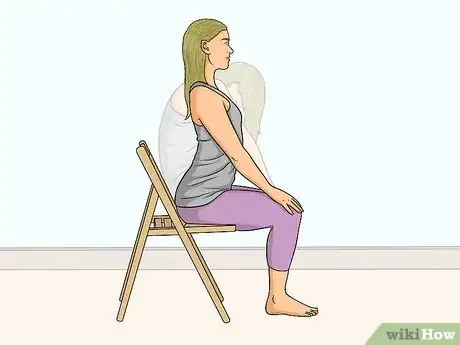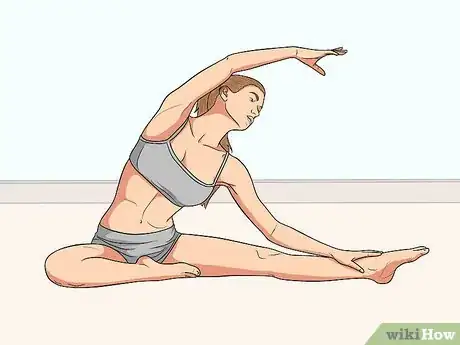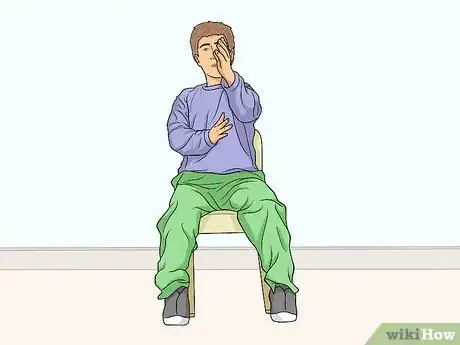This article was co-authored by Mayami Oyanagi and by wikiHow staff writer, Jennifer Mueller, JD. Mayami Oyanagi is a Physical Therapist and the owner of PT STOP Physical Therapy & Wellness, an individualized physical therapy practice in Los Angeles, California. With over 14 years of experience, Mayami specializes in orthopedic injuries, manual therapy, and sports medicine. She holds an MS in Physical Therapy from the University of Hartford. Mayami is also a board certified Orthopedic Clinical Specialist. She treats the root cause of her client’s problems by utilizing biomechanical assessments.
There are 8 references cited in this article, which can be found at the bottom of the page.
This article has been viewed 29,562 times.
Exercise is important to boost your mood, outlook, and overall quality of life – even if you have limited mobility. When your mobility is limited, whether by injury, illness, or disability, it just means you might have to get creative in how you get your exercise. Choose low-impact exercises that will still help you build strength and increase your flexibility. Do chair exercises if limited mobility in your legs requires you to use a wheelchair, cane, or walker. Always consult your health care provider before you begin any new exercise regimen or activity.[1]
Steps
Exercising in a Chair
-
1Choose the correct chair. When you do exercises in a chair, make sure the chair is stable and you can put your feet flat on the floor with your knees at a 90-degree angle and your thighs parallel to the floor.[2]
- If you're in a wheelchair, make sure you apply the brakes or otherwise immobilize the chair before you begin exercising.
-
2Do the sit to stand exercise. If you have limited mobility, start from a chair with this basic exercise. As the name suggests, all you do is sit in a chair, stand up straight, then sit back down again.[3]
- Sit up straight at the edge of the chair with your feet flat on the floor. As you stand, try to keep your knees directly above your ankles. Keep your head lifted and your spine straight.
- Start off with 10 repetitions of this exercise.
Advertisement -
3Build arm strength with a triceps dip. For this exercise, you'll need a chair with armrests. Resting your feet flat on the floor, grip the armrests and extend your elbows to raise yourself off the chair.[4]
- Lower back down with a slow, controlled movement – don't simply drop back down into the chair.
- Do 10 repetitions of this exercise to start, making sure you keep your feet flat on the floor.
-
4Adapt gym exercises. If you need to exercise in a chair, that doesn't mean you can't lift weights. Many strength training exercises you normally would do on a weight bench or with dumbbells can be modified for a chair.[5]
- If you're interested in starting with a class, check in your local area for a gym that offers wheelchair or other chair strength training or weightlifting classes. You also might be able to find some videos you can follow online.
-
5Try chair aerobics to get your blood pumping. Even if you're in a wheelchair, you can still get cardiovascular exercise with chair aerobics, which involve a series of upper body and arm movements.[6]
- Your local fitness center or health club may have chair aerobics classes. You also might check at your local community center or even a senior care facility.
-
6Use chair yoga or tai chi to increase your flexibility. Yoga and tai chi improve your physical strength and flexibility as well as your mental balance. These practices have been adapted so that people with limited mobility can still participate.[7]
- Look for chair classes in your area. Retirement communities can be a good place to look. You also might ask a local instructor if they're aware of any classes nearby.
Building Strength
-
1Work with your doctor or physical therapist. In some situations, your doctor or physical therapist may prescribe specific exercises or movements that you should do. This is especially common if you have limited mobility due to a recent injury.[8]
- The exercises and activities prescribed by your doctor or physical therapist are designed to help you avoid muscle deterioration or loss as a result of inactivity from limited mobility.
- For example, you may be prescribed isometric exercises, in which you push against an object or another part of your body without moving the joint.
-
2Start with a warm-up. No matter what kind of physical activity you're doing, you need to warm up first to get your blood flowing and your muscles ready to work. Skipping a warm-up can lead to cramps and other injuries.[9]
- Likewise, you should end any exercise routine with some stretching and cooling down to lower your heart rate after activity.
- Some ideas for a good warm-up include walking or jogging in place, arm and leg lifts or circles, and shoulder rolls. Generally, you just want to move your body all around and get it loose and ready to move.
-
3Choose exercises related to your daily life. You have a lot of options in terms of how to exercise and the types of exercises to do. If you have limited mobility, focus on exercises that mimic actions you normally perform throughout the day.[10]
- For example, if you're often reaching into high cupboards, look for exercises that involve lifting overhead or improving the range of motion in your shoulders, such as overhead presses and triceps extensions.
-
4Avoid exercising injured body parts. When you have limited mobility, you shouldn't try to exercise parts of your body that are injured or otherwise limited. Reduce or limit your range of motion to keep all exercises pain free. A personal trainer or exercise instructor can work with you to create a fitness routine that fits your abilities.[11]
-
5Start slow. If you're just starting to exercise, go for a few minutes each day. Get used to being active and make it a part of your regular routine, then gradually increase the length of time you exercise each day.[12]
- Set small, reachable goals for yourself. For example, if your overall goal is to lose 20 pounds, you might set a smaller goal of losing a pound a week. Keep track of your progress and allow yourself a small reward for each successful week.
-
6Add weight gradually. When you have limited mobility, start strength training with the lowest weight possible. Increase repetitions first, then increase the weight. You can use soup cans or other household items if you can't find dumbbells light enough to start.[13]
- For example, you might start doing 2 sets of 5 repetitions of bicep curls with 2-pound dumbbells. After a week or two, do 2 sets of 7 repetitions, then 3 sets of 5 repetitions. When you're up to 3 sets of 10 repetitions, move up to 3-pound dumbbells.
-
7Take to the water. A water aerobics class is a low-impact way to build muscles as well as increase your cardiovascular strength. The water both supports your body and adds resistance as you move through it.[14]
- Check at your local fitness center or health club to find out what water exercise classes are available. Ask if there are any classes specifically for people with limited mobility.
-
8Use a stationary bike for cardiovascular exercise. Cycling is a relatively low-impact, whole-body workout that is easy on the joints. Stationary bikes typically are easier because you can control the resistance and don't have to worry about balancing the bike on rough terrain.[15]
- You also may be able to find a portable pedal machine. You can set these machines in front of your chair or sofa and get exercise while watching television or reading a book.
-
9Get exercise with recreational activities. Many recreational and everyday activities also may provide exercise if you have limited mobility. Think of the things you enjoy doing, such as gardening or fishing, and try to incorporate them into your regular schedule.[16]
- For example, fishing can help increase the strength and range of motion in your arms and shoulders.
- Go for a walk with a friend so you can socialize while you're getting some exercise.
Increasing Flexibility
-
1Start with basic stretching. A regular stretching routine can improve your flexibility and increase your range of motion over time. Warm up before you start your stretching routine, and only stretch as far as you can without pain or discomfort.
- Practice breathing deeply as you stretch. Don't continue stretching if you find yourself holding your breath, gasping, or otherwise unable to breathe through the stretch.
- Control your movements going into and coming out of the stretch. Return to the start position slowly rather than simply dropping out of the stretch.
-
2Try yoga. All yoga poses can be modified for people with limited mobility. A regular yoga practice may increase your range of motion as well as improving your balance and making you more flexible.[17]
- Typically your best bet is to join a class locally so you'll have the benefit of a professional instructor to assist you and make sure you're doing the poses correctly.
- Don't try yoga at home if you have no experience with the practice, especially if you have a chronic condition such as arthritis or are recovering from a recent injury.
-
3Join a pilates class. If you have limited mobility, pilates may significantly improve your flexibility and range of motion. Look for a "gentle pilates" class, particularly one specifically designed for people with limited mobility.[18]
- Many gentle pilates classes are mat-based. Talk with the instructor if you have difficulty getting down onto the floor and then back up again.
- Make sure you discuss your specific physical limitations with your instructor so they'll know when you need additional assistance.
-
4Practice tai chi to improve your balance and flexibility. The slow movements of tai chi are low-impact and suitable for people with limited mobility. The practice has other benefits, including increased calmness and mental outlook.[19]
- You typically can find a tai chi class locally by checking senior or community centers, health clubs, or even hospitals in your area. Many tai chi classes are specifically designed for people with limited mobility, such as those with arthritis.
- Talk to the instructor before you take the class and explain your limitations. Find out how much experience they have working with people who have the same limitations or health conditions as you.
Expert Q&A
-
QuestionHow do you exercise with limited mobility?
 Mayami OyanagiMayami Oyanagi is a Physical Therapist and the owner of PT STOP Physical Therapy & Wellness, an individualized physical therapy practice in Los Angeles, California. With over 14 years of experience, Mayami specializes in orthopedic injuries, manual therapy, and sports medicine. She holds an MS in Physical Therapy from the University of Hartford. Mayami is also a board certified Orthopedic Clinical Specialist. She treats the root cause of her client’s problems by utilizing biomechanical assessments.
Mayami OyanagiMayami Oyanagi is a Physical Therapist and the owner of PT STOP Physical Therapy & Wellness, an individualized physical therapy practice in Los Angeles, California. With over 14 years of experience, Mayami specializes in orthopedic injuries, manual therapy, and sports medicine. She holds an MS in Physical Therapy from the University of Hartford. Mayami is also a board certified Orthopedic Clinical Specialist. She treats the root cause of her client’s problems by utilizing biomechanical assessments.
Physical Therapist It totally depends on the nature of your injury and what kind of mobility issues you're dealing with. Ask your doctor or talk to a physical therapist to get guidance on what kind of exercises you're able to do.
It totally depends on the nature of your injury and what kind of mobility issues you're dealing with. Ask your doctor or talk to a physical therapist to get guidance on what kind of exercises you're able to do. -
QuestionWhy are aquatic workouts so good for you when you have limited mobility?
 Mayami OyanagiMayami Oyanagi is a Physical Therapist and the owner of PT STOP Physical Therapy & Wellness, an individualized physical therapy practice in Los Angeles, California. With over 14 years of experience, Mayami specializes in orthopedic injuries, manual therapy, and sports medicine. She holds an MS in Physical Therapy from the University of Hartford. Mayami is also a board certified Orthopedic Clinical Specialist. She treats the root cause of her client’s problems by utilizing biomechanical assessments.
Mayami OyanagiMayami Oyanagi is a Physical Therapist and the owner of PT STOP Physical Therapy & Wellness, an individualized physical therapy practice in Los Angeles, California. With over 14 years of experience, Mayami specializes in orthopedic injuries, manual therapy, and sports medicine. She holds an MS in Physical Therapy from the University of Hartford. Mayami is also a board certified Orthopedic Clinical Specialist. She treats the root cause of her client’s problems by utilizing biomechanical assessments.
Physical Therapist When you're in the pool, the water provides a kind of cushion for your joints. This makes it a lot easier for people with limited mobility to get their heart rate up in the water.
When you're in the pool, the water provides a kind of cushion for your joints. This makes it a lot easier for people with limited mobility to get their heart rate up in the water. -
QuestionIs it better to just not move if it's causing me pain?
 Mayami OyanagiMayami Oyanagi is a Physical Therapist and the owner of PT STOP Physical Therapy & Wellness, an individualized physical therapy practice in Los Angeles, California. With over 14 years of experience, Mayami specializes in orthopedic injuries, manual therapy, and sports medicine. She holds an MS in Physical Therapy from the University of Hartford. Mayami is also a board certified Orthopedic Clinical Specialist. She treats the root cause of her client’s problems by utilizing biomechanical assessments.
Mayami OyanagiMayami Oyanagi is a Physical Therapist and the owner of PT STOP Physical Therapy & Wellness, an individualized physical therapy practice in Los Angeles, California. With over 14 years of experience, Mayami specializes in orthopedic injuries, manual therapy, and sports medicine. She holds an MS in Physical Therapy from the University of Hartford. Mayami is also a board certified Orthopedic Clinical Specialist. She treats the root cause of her client’s problems by utilizing biomechanical assessments.
Physical Therapist You'll need to talk to your doctor to figure out what you're able to do. However, you're definitely not going to be better off staying in a static position. It's just not good for your joints to stay still for extended periods of time.
You'll need to talk to your doctor to figure out what you're able to do. However, you're definitely not going to be better off staying in a static position. It's just not good for your joints to stay still for extended periods of time.
Warnings
- Work closely with your doctor if you've decided to start exercising but have limited mobility. They will be able to tell you what exercises will be best for you.[21]⧼thumbs_response⧽
- If you experience any pain, discomfort, or shortness of breath while exercising, stop doing the activity immediately and assess the situation. Don't exercise through pain, as you can cause injury.[22]⧼thumbs_response⧽
References
- ↑ https://www.helpguide.org/articles/healthy-living/chair-exercises-and-limited-mobility-fitness.htm
- ↑ https://www.helpguide.org/articles/healthy-living/chair-exercises-and-limited-mobility-fitness.htm
- ↑ https://eldergym.com/vital-exercises-for-those-with-limited-mobility/
- ↑ https://eldergym.com/vital-exercises-for-those-with-limited-mobility/
- ↑ http://blog.ncpad.org/2013/03/27/5-effective-exercises-for-people-with-limited-mobility/
- ↑ https://www.helpguide.org/articles/healthy-living/chair-exercises-and-limited-mobility-fitness.htm
- ↑ https://www.helpguide.org/articles/healthy-living/chair-exercises-and-limited-mobility-fitness.htm
- ↑ Mayami Oyanagi. Physical Therapist. Expert Interview. 27 January 2021.
- ↑ https://www.helpguide.org/articles/healthy-living/chair-exercises-and-limited-mobility-fitness.htm
- ↑ https://eldergym.com/vital-exercises-for-those-with-limited-mobility/
- ↑ https://www.helpguide.org/articles/healthy-living/chair-exercises-and-limited-mobility-fitness.htm
- ↑ http://www.uwhealth.org/health-wellness/exercise-options-for-people-with-limited-mobility/49288
- ↑ https://eldergym.com/vital-exercises-for-those-with-limited-mobility/
- ↑ Mayami Oyanagi. Physical Therapist. Expert Interview. 27 January 2021.
- ↑ https://www.helpguide.org/articles/healthy-living/chair-exercises-and-limited-mobility-fitness.htm
- ↑ http://blog.ncpad.org/2013/03/27/5-effective-exercises-for-people-with-limited-mobility/
- ↑ http://www.fitday.com/fitness-articles/fitness/4-ways-people-with-limited-mobility-can-start-exercising.html
- ↑ https://www.disabled-world.com/fitness/exercise/pilates/
- ↑ http://www.health.harvard.edu/blog/tai-chi-can-improve-life-for-people-with-chronic-health-conditions-201509248349
- ↑ https://www.helpguide.org/articles/healthy-living/chair-exercises-and-limited-mobility-fitness.htm
- ↑ https://www.helpguide.org/articles/healthy-living/chair-exercises-and-limited-mobility-fitness.htm
- ↑ https://www.helpguide.org/articles/healthy-living/chair-exercises-and-limited-mobility-fitness.htm
